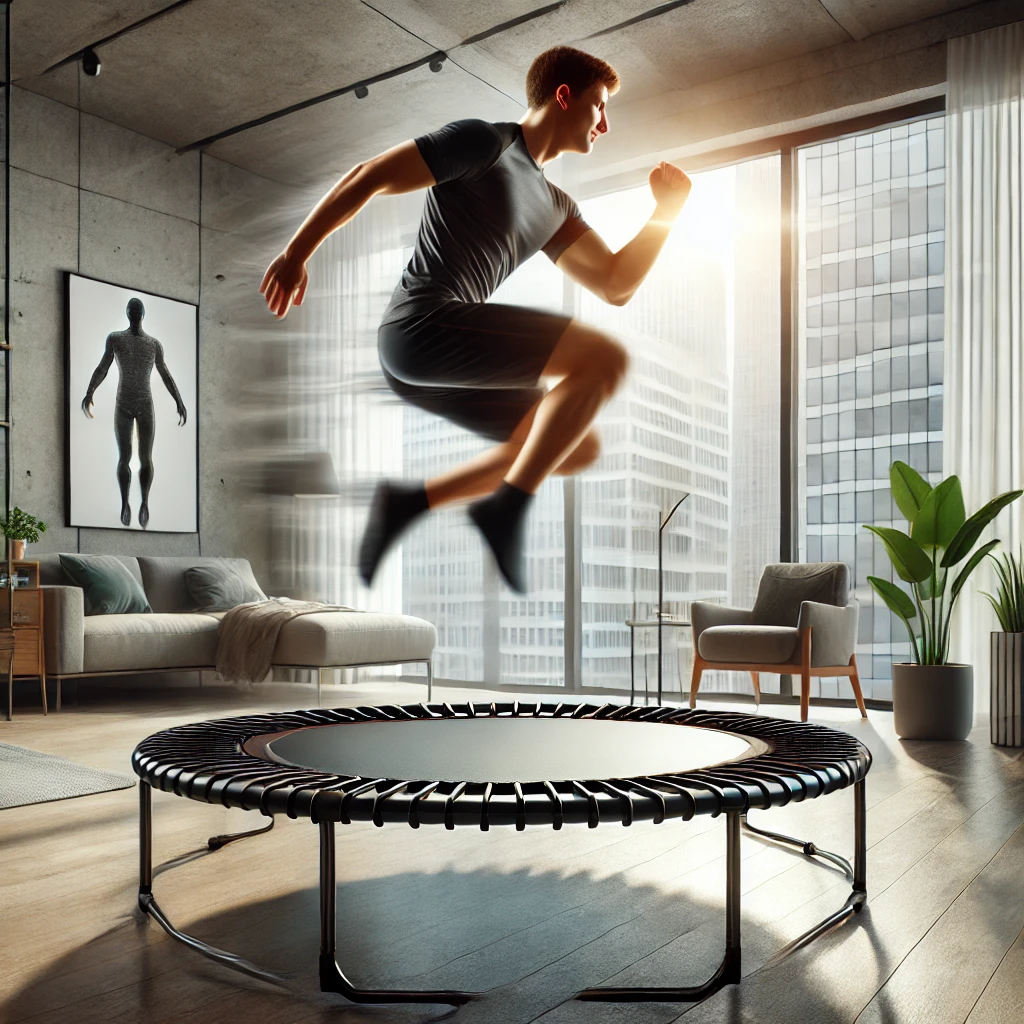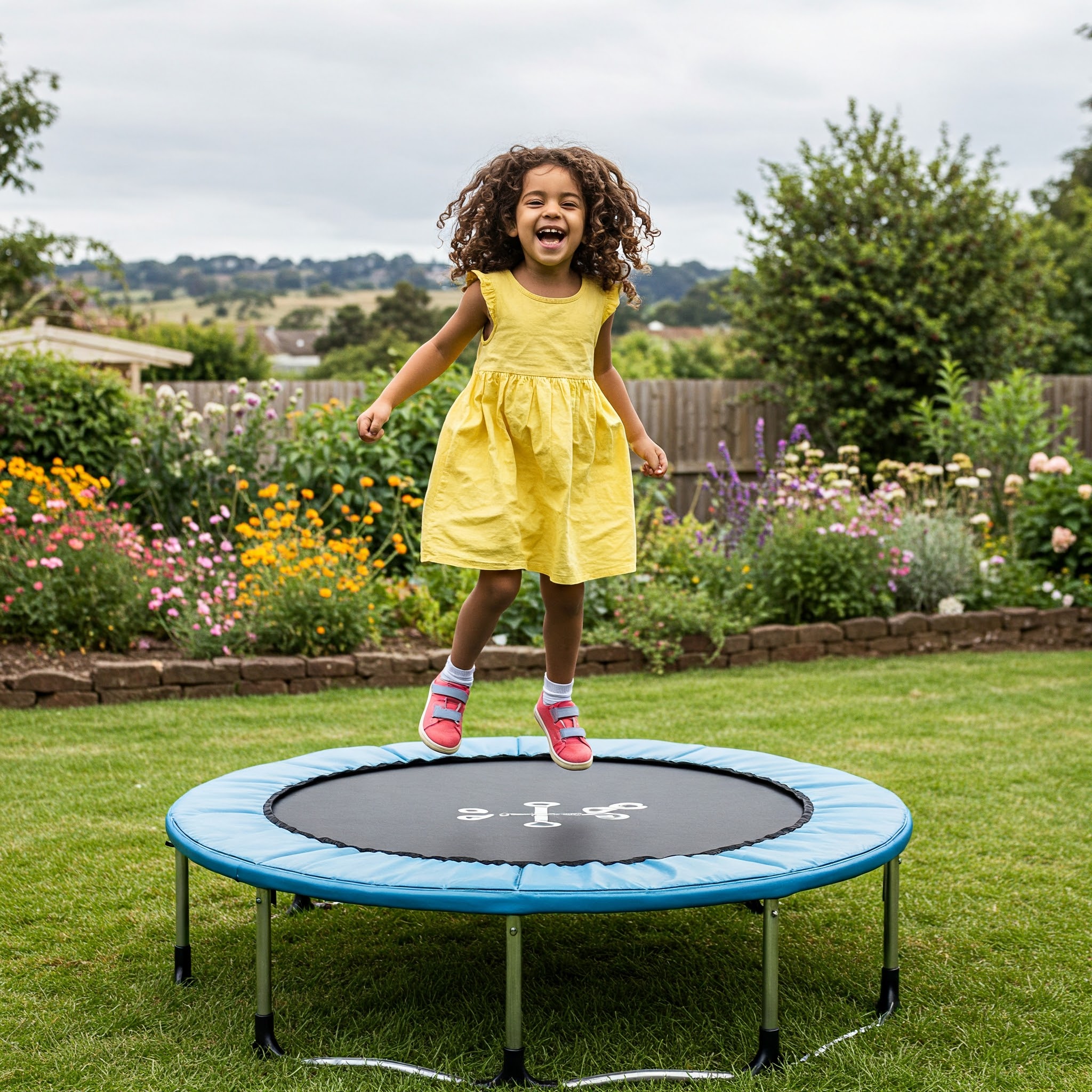The Ultimate Guide to Bouncing Your Way to Peak Performance
Hey there fitness enthusiasts! I’m thrilled you’ve bounced your way to this comprehensive guide on gymnastics trampolines. As someone who’s spent over a decade training and coaching on these springy wonders, I can’t wait to share everything you need to know about this exhilarating sport and fitness activity that’s taking the USA by storm.
When I first stepped onto a gymnastics trampoline, I had no idea how it would transform not just my physical abilities but my entire approach to fitness. That’s why I’ve created this ultimate resource to help you understand the incredible benefits, essential equipment, proper techniques, and safety considerations for gymnastics trampoline training.
So, whether you’re a curious beginner, a parent looking into activities for your child, or a fitness buff seeking to add some airborne excitement to your routine, strap in (not literally—that comes later!) as we bounce through everything you need to know about gymnastics trampolines.
What Exactly Is a Gymnastics Trampoline?
A gymnastics trampoline isn’t just your average backyard bouncer. In fact, competitive gymnastics trampolines are specialized pieces of equipment designed for maximum rebound and precise technical movements. Unlike recreational models, these professional-grade trampolines feature:
✅ Higher-tension springs for greater bounce height
✅ Larger jumping surfaces (typically 7’x14′)
✅ Specialized safety padding
✅ Higher-grade materials for consistent performance
✅ Competition-standard specifications
Gymnastics trampolining became an official Olympic sport in 2000, and since then, its popularity has soared in the United States. What makes this discipline unique is the combination of height, control, technique, and artistry required to execute complex aerial maneuvers while maintaining perfect form.

7 Incredible Benefits of Gymnastics Trampoline Training ⚡
Trampoline training isn’t just incredibly fun—it’s also packed with health and fitness benefits that might surprise you!
1. Full-Body Workout Without Joint Strain
Unlike high-impact exercises such as running or traditional plyometrics, trampoline training provides a comprehensive workout while significantly reducing impact on your joints. When you bounce on a trampoline, the flexible surface absorbs much of the shock that would otherwise travel through your ankles, knees, and hips.
“I switched to trampoline training after a running injury, and I’ve been able to maintain my fitness while giving my joints the break they needed,” I often tell my clients who are recovering from injuries or dealing with joint pain.
2. Improves Balance and Coordination
Maintaining stability on a moving surface requires constant adjustments from your body. These micro-corrections strengthen your core and improve your proprioception—your body’s awareness of its position in space. Additionally, the need to coordinate multiple body parts during complex movements enhances overall body coordination.
Think of it this way: when you’re executing even a simple seat drop on a trampoline, your body needs to:
- Control the height of your jump
- Position your legs correctly
- Time your landing precisely
- Maintain proper upper body posture
All these elements working together significantly boost your neural pathways responsible for balance and coordination.
3. Strengthens Core Muscles
Every bounce on a gymnastics trampoline engages your core muscles as they work to stabilize your body. Unlike traditional ab exercises that target specific muscle groups, trampoline training forces your entire core—including deep stabilizing muscles—to engage continuously.
The result? A stronger, more functional core that supports better posture and reduced back pain. In fact, many physical therapists now incorporate trampoline exercises into rehabilitation programs specifically for core strengthening.
4. Boosts Cardiovascular Health
Don’t let the fun fool you—trampoline training is serious cardio! Research has shown that 10 minutes of bouncing can be equivalent to a 30-minute run in terms of cardiovascular benefits and calorie burn. The constant resistance against gravity as you bounce up and down increases your heart rate and improves circulation.
What’s particularly beneficial is that trampoline workouts can easily be adjusted for interval training—alternating between high-intensity bouncing and recovery periods—which is proven to be highly effective for cardiovascular health and endurance building.
5. Enhances Lymphatic System Function
The lymphatic system plays a crucial role in immunity and fluid balance but lacks its own pump (unlike the circulatory system with the heart). The up-and-down movement of bouncing acts as a pump for your lymphatic system, helping to flush toxins and boost immune function.
“The vertical movement creates a sort of vacuum effect that helps lymph flow more efficiently through your body,” I explain to health-conscious clients looking to support their immune systems naturally.
6. Improves Bone Density
While trampoline exercise reduces joint impact, it still provides enough resistance to stimulate bone strengthening. The gravitational forces experienced during bouncing—particularly at the peak of each jump—stimulate bone formation and help maintain bone density.
This makes trampoline training especially valuable for:
- Growing children developing bone mass
- Adults looking to prevent age-related bone loss
- Women at risk for osteoporosis
7. Enhances Mental Well-being
The combination of physical exercise, the sensation of weightlessness, and the pure joy of bouncing creates a powerful mood-boosting experience. Trampoline training triggers the release of endorphins—your body’s natural feel-good chemicals—while the focus required for safe bouncing provides a form of moving meditation that can reduce stress and anxiety.
Many of my adult students report that their trampoline sessions are the highlight of their week, offering a rare opportunity to experience childlike joy while getting a serious workout.
Essential Equipment for Gymnastics Trampoline Training
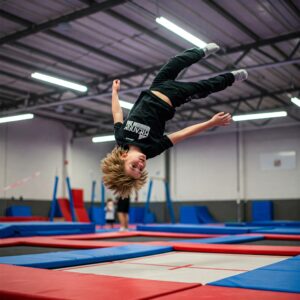
Having the right equipment is crucial for safe and effective trampoline training. Here’s what you need to get started:
The Trampoline Itself
For serious gymnastics training, you’ll want to invest in a quality rectangular trampoline designed specifically for gymnastics. These provide more consistent bounce across the entire surface and better performance for technical skills.
One standout option is the Springfree Gymnastic Rectangle Trampoline. This innovative design eliminates exposed springs, dramatically reducing injury risk while providing excellent performance for gymnastics training. The flexible composite rods placed beneath the jumping surface create a smooth, consistent bounce perfect for developing proper technique.
For those on a budget but still seeking quality, the JUMPZYLLA Rectangular Gymnastics Trampoline offers a good balance of performance and affordability. With a sturdy frame and high-tension springs, it provides the rectangular shape preferred by gymnastics coaches while being accessible to home users.
Safety Equipment
Safety should always be your top priority when engaging in trampoline activities. Here’s what you’ll need:
Enclosures
A quality safety enclosure is non-negotiable, especially for home use. The SkyBound Trampoline Enclosure Net is compatible with most rectangular trampolines and features a fine mesh design that prevents fingers and toes from getting caught while providing excellent durability.
Padding
Spring and frame padding protects jumpers from hard surfaces. The Upper Bounce Trampoline Pole Foam Sleeves provide extra cushioning for enclosure poles, while the Skywalker Trampolines Spring Pad offers comprehensive coverage for the springs and frame.
Training Aids
To progress safely through gymnastics skills, these training aids are invaluable:
Spotting Belt
For learning new skills, a spotting belt connected to overhead support allows coaches to assist with rotation and height. The AAI Spotting Belt is the gold standard used in many gymnastics facilities.
Crash Mats
When practicing new landing positions or skills, crash mats provide additional safety. The Z-Athletic Gymnastics Crash Mat offers the perfect balance of cushioning and support for trampoline training.
Comparison Table: Top Gymnastics Trampolines for Home Use
| Trampoline Model | Size | Weight Limit | Special Features | Best For |
|---|---|---|---|---|
| Springfree Gymnastic Rectangle | 10’x13′ | 330 lbs | No exposed springs, flexible composite rods | Serious gymnasts, safety-conscious families |
| JUMPZYLLA Rectangular | 10’x17′ | 400 lbs | Heavy-duty frame, competition-grade springs | Competitive training, multiple users |
| Skywalker Rectangle Trampoline | 8’x14′ | 250 lbs | Enclosure included, no-gap design | Beginners, recreational users |
| Acon Air 16 Sport Trampoline | 9’x16′ | 550+ lbs | Heavy springs, weatherproof design | All-season training, multiple users |
Ready to elevate your trampoline experience? The right equipment makes all the difference in safety and performance. Check out these top-rated options today and transform your backyard into a gymnastics training center! Your body will thank you for making this investment in your fitness journey.
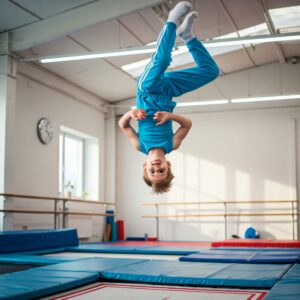
Proper Techniques for Gymnastics Trampoline Training ♂️
Now that we’ve covered the equipment, let’s dive into the techniques that will help you progress safely and effectively in your trampoline training:
Starting Position: The Foundation of Good Technique
Every successful trampoline session begins with the proper starting position:
- Stand in the center of the trampoline
- Place feet shoulder-width apart
- Slightly bend your knees
- Keep your back straight
- Hold arms slightly forward at shoulder height
- Fix your gaze on a spot at the end of the trampoline
This position creates stability and readiness for controlled bouncing. I always tell my students, “Your starting position is like building a house—if the foundation isn’t solid, everything built on top will be unstable.”
Basic Bouncing: Building Block Skills
Before attempting any advanced moves, master these fundamental techniques:
1. Basic Straight Jump
The straight jump is deceivingly simple but crucial for developing control:
- Begin with small bounces to feel the trampoline’s response
- Gradually increase height while maintaining center position
- Keep your body straight with arms raised overhead at the peak
- Land with feet flat and knees slightly bent to absorb impact
“The quality of your straight jump reflects your overall trampoline control,” I remind students who rush to learn tricks before mastering basics.
2. Controlled Stop
Being able to safely stop your bounce is as important as the bouncing itself:
- After a bounce, bend your knees deeply upon landing
- Press your feet firmly into the trampoline bed
- Allow your legs to absorb the rebound energy rather than redirecting it upward
- Use your arms for balance by extending them to the sides
Progression Skills for Development
Once you’ve mastered basic bouncing, these skills help develop the foundations for more advanced techniques:
1. Seat Drop
This fundamental position teaches control and body awareness:
- Begin with a straight jump
- At the peak, extend your legs forward and arms back
- Land in a seated position with legs straight and hands slightly behind hips
- Push with your hands and swing arms forward to return to feet
2. Swivel Hips
This move introduces rotation while maintaining control:
- Perform a seat drop
- As you push to return to feet, twist your hips and legs 180°
- Land in a seat drop facing the opposite direction
- Continue the pattern, creating a back-and-forth rotation
3. Front Drop
The front drop develops core strength and body tension:
- Start with a straight jump (lower height for beginners)
- Bring your chest forward and arms out to create a slight arch
- Land on your stomach with arms extended and head up
- Push with your hands to return to standing
Safety tip: Always practice front drops with a qualified instructor first, as improper technique can lead to face or arm injuries.
Advanced Techniques for Competitive Development
For those pursuing competitive trampoline gymnastics, these advanced techniques form the building blocks of competitive routines:
1. Back Drop
This skill introduces backward landing positions:
- From a straight jump, lift your hips and bring your chest back
- Land on your upper back with legs lifted and arms to the sides
- Return to feet by bringing knees to chest and swinging arms forward
2. Tuck Jump
The tuck introduces body position changes mid-air:
- Perform a high straight jump
- At the peak, quickly pull knees to chest and grab shins
- Release and extend body before landing
3. Introduction to Somersaults
Front and back somersaults require proper progression and usually spotting assistance:
- Master front drops and back drops first
- Work with a qualified coach using spotting techniques
- Use progression drills like rolling over crash mats before attempting in the air
“Never rush progression with rotation skills,” I caution my students. “Each prerequisite skill builds not just technique but also the body awareness and strength needed for safety.”
Safety Considerations: Bouncing Responsibly ️
Trampoline gymnastics is exhilarating but requires respect for safety protocols to prevent injuries:
General Safety Rules
Always follow these non-negotiable safety guidelines:
- One person on the trampoline at a time (especially important for home trampolines)
- Always use safety enclosures and padding
- Remove jewelry and empty pockets before jumping
- Never bounce when tired or impaired
- Always have supervision, especially for children and when learning new skills
Proper Warm-Up Protocol
Prepare your body properly with this warm-up routine:
- 5 minutes of light cardio (jogging or jumping jacks)
- Dynamic stretching focusing on ankles, knees, hips, and shoulders
- Gentle bouncing to acclimate to the trampoline surface
- Gradual progression from basic to more complex movements
“Your body is like an elastic band,” I explain to my students. “If it’s cold, it can snap when stretched suddenly. Warming up is non-negotiable for safety.”
Common Injuries and Prevention
Knowledge of potential risks helps prevent them:
Ankle Sprains
- Prevention: Always land in the center of the trampoline with proper foot position
- Strengthening: Regular ankle conditioning exercises
- Equipment: Consider SENTEQ Ankle Compression Sleeves for added support during training
Knee Strains
- Prevention: Maintain proper landing technique with slight knee flexion
- Technique: Avoid hyperextending knees during landings
- Support: For those with previous knee issues, the McDavid Knee Compression Sleeve provides moderate support without restricting movement
Wrist Injuries
- Prevention: Proper hand position during skills requiring hand contact
- Conditioning: Wrist strengthening exercises
- Protection: The ProCare Universal Wrist Support can be helpful during rehabilitation from previous injuries
Getting Started: From Beginner to Competitor
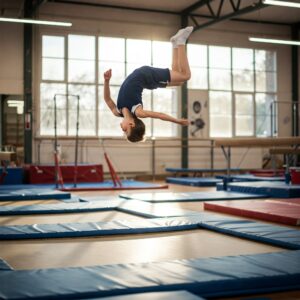
Whether you’re looking to enjoy trampoline gymnastics recreationally or pursue competitive pathways, here’s how to begin your journey:
Finding Qualified Instruction
The right coaching makes all the difference:
- Look for gyms with USA Gymnastics certified trampoline coaches
- Ask about coach certifications and specific trampoline training
- Consider starting with private lessons before group classes
- For home practice, consider hiring a coach for occasional technique check-ins
“Good coaching isn’t about pushing you to do more tricks faster,” I tell parents. “It’s about building a systematic progression that develops skills safely.”
Home Practice vs. Gym Training
Balance these two training environments for optimal progress:
Gym Advantages:
- Professional equipment with proper specifications
- Qualified supervision and spotting
- Structured progression and feedback
- Safety systems like overhead harnesses for learning new skills
Home Practice Benefits:
- Convenience and additional practice time
- Family involvement
- Opportunity to reinforce basic techniques
- Conditioning and endurance development
The ideal approach combines both: “Use gym time to learn proper technique and new skills under supervision, and home practice to reinforce fundamentals and build conditioning,” I advise my students seeking rapid progress.
Setting Realistic Goals
Create a roadmap for your trampoline journey:
- Short-term goals (1-2 months): Master basic positions and transitions
- Medium-term goals (3-6 months): Develop routine combinations and flow
- Long-term goals (6+ months): Competitive skills or personal achievements
For those interested in competition, familiarize yourself with the USA Gymnastics trampoline pathway and requirements for different levels.
Competitive Pathway: Taking Your Trampoline Skills to the Next Level
For those interested in competitive trampoline gymnastics, here’s what you need to know:
Understanding Competition Levels
USA Gymnastics structures trampoline competitions into progressive levels:
- Youth/Development levels (focusing on fundamentals)
- Levels 1-4 (introductory competitive skills)
- Levels 5-7 (intermediate skills and routines)
- Levels 8-10 (advanced national-level skills)
- Elite (international competitive level)
Each level has specific routine requirements, difficulty expectations, and advancement criteria.
Competition Equipment Requirements
As you advance in competitive trampolining, equipment specifications become increasingly important:
Competition Attire
- Girls: Gymnastics leotard, hair secured
- Boys: Competition singlet/shorts or unitard
- All: No jewelry, watches, or loose items
The GK Elite Women’s Gymnastics Leotard and GK Elite Men’s Competition Shirt and Shorts meet all competition requirements while providing comfort and freedom of movement.
Personal Equipment
- Trampoline shoes: While optional, many competitors prefer the added toe-point definition and grip provided by trampoline shoes
- The Sasaki Trampoline Shoes offer excellent sensitivity while providing minimal protection
Training for Competition
Competitive success requires structured preparation:
- Consistent technique training (3-4 sessions weekly)
- Strength and flexibility conditioning (focus on core, legs, and shoulders)
- Mental preparation and visualization techniques
- Routine practice with emphasis on consistency and execution
“Competition success is 90% preparation and 10% performance,” I remind my competitive athletes. “The work you do in regular practice determines your competition outcome.”
Trampoline Gymnastics for Different Age Groups
Trampoline training offers benefits across the lifespan, with appropriate modifications for different age groups:
Children (4-12 years)
Kids naturally love bouncing, but structured training provides additional benefits:
- Develops fundamental movement patterns and coordination
- Builds body awareness and spatial orientation
- Teaches discipline and progression
- Provides healthy outlet for energy
Safety considerations:
- Always provide direct supervision
- Focus on basic positions before height
- Use age-appropriate equipment
- Keep sessions short (30-45 minutes) and playful
The Little Tikes 7′ Enclosed Trampoline provides a safer starting point for younger children, with lower height and full enclosure.
Teens (13-18 years)
Adolescence is often when competitive potential emerges:
- Focus on technical precision and consistency
- Introduce more complex skill combinations
- Develop performance quality and style
- Balance skill development with proper conditioning
“Teenage years are prime for technical development,” I explain to parents. “The combination of strength, fearlessness, and learning capacity creates an optimal window for skill acquisition.”
Adults (19+ years)
It’s never too late to start trampoline training:
- Emphasize quality movement over difficulty
- Focus on fitness benefits alongside skill development
- Pay special attention to proper warm-up and recovery
- Modify training volume based on individual recovery needs
Many of my adult students find trampoline training to be the perfect complement to their existing fitness routines, providing variety and new challenges.
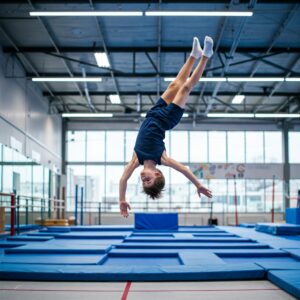
Frequently Asked Questions About Gymnastics Trampolines
Is trampoline gymnastics dangerous?
Like any sport, trampoline gymnastics carries some risk, but proper instruction, equipment, and progression significantly reduce this risk. Statistics show that with proper supervision and safety measures, trampoline gymnastics has a lower injury rate than many traditional sports like football or soccer.
How often should I train on a trampoline?
For recreational purposes, 2-3 sessions per week of 30-60 minutes provides excellent fitness benefits while allowing for recovery. Competitive trampolinists typically train 4-5 times weekly with structured programs balancing technical work, conditioning, and recovery.
Can I lose weight with trampoline training?
Absolutely! Trampoline exercise can burn between 500-1,000 calories per hour, depending on intensity. Many of my clients have achieved significant weight loss goals through consistent trampoline training combined with proper nutrition.
What’s the difference between a backyard trampoline and a gymnastics trampoline?
Gymnastics trampolines feature rectangular shapes, higher-tension springs, more substantial frames, and larger jumping surfaces than typical backyard models. They’re designed for higher performance, greater durability, and more precise technical movements.
Can adults start trampoline gymnastics without prior experience?
Yes! Many of my adult students began with no gymnastics background. The key is following proper progression, starting with fundamentals, and working with qualified instruction. Adults often progress steadily due to better body awareness and commitment to technique.
How high can competitive trampolinists bounce?
Elite trampolinists can reach heights of 30+ feet (9+ meters) during competition, though this requires years of training and professional equipment. Recreational and developmental trampolinists typically work at much lower heights, focusing on control rather than maximum elevation.
Maintenance and Care for Your Gymnastics Trampoline
To ensure safety and longevity of your equipment:
Regular Inspection Routine
Implement this monthly safety check:
- Examine all springs for stretching or damage
- Check frame for stability and alignment
- Inspect jumping mat for tears or excessive wear
- Test all safety padding for proper positioning
- Check enclosure netting for holes or sagging
Cleaning and Protection
Maintain your equipment with:
- Regular removal of leaves and debris
- Gentle cleaning of the mat with mild soap and water
- Protection from extreme weather with a Ultcover Trampoline Cover
- Application of rust prevention on metal parts
When to Replace Parts
Even with excellent maintenance, parts require replacement:
- Springs: Every 2-3 years with regular use
- Safety padding: Every 3-5 years depending on sun exposure
- Jumping mat: Every 5-7 years
- Enclosure netting: Every 2-4 years
“Think of your trampoline maintenance like car maintenance,” I explain. “Regular small investments prevent major failures and keep everyone safe.”
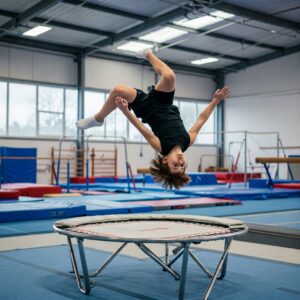
Conclusion: Your Gymnastics Trampoline Journey Begins Now
Whether you’re bouncing for fitness, fun, or competitive aspirations, gymnastics trampoline training offers a unique combination of physical benefits, mental challenges, and pure enjoyment that few other activities can match. From the incredible full-body workout to the exhilaration of mastering new skills, trampoline gymnastics provides a lifetime of growth opportunities.
As you begin or continue your trampoline journey, remember that consistency and proper technique will take you further than rushing into advanced skills. Take the time to build your foundation, seek qualified instruction, and above all, maintain a playful spirit of enjoyment through the process.
“The best trampolinists I know have maintained their childlike joy of bouncing,” I often reflect. “They’ve simply layered technical precision on top of that fundamental love of flight.”
Ready to experience the transformative benefits of trampoline training yourself? The essential equipment we’ve discussed in this guide will help you start safely and effectively. Check out these recommended products today and take the first bounce toward better fitness, improved skills, and countless hours of healthy enjoyment!
More FQAs:
❓ What is the difference between a gymnastics trampoline and a recreational trampoline?
✅ Gymnastics trampolines are designed for higher performance with enhanced bounce and durability, featuring sturdy steel frames and high-tension springs, while recreational trampolines are typically less robust, intended for casual use...
❓ How does trampoline training benefit gymnasts' performance?
✅ Trampoline training enhances aerial awareness, coordination, and control, allowing gymnasts to practice complex maneuvers safely and effectively, thereby improving overall performance...
❓ What safety measures should be taken when using a gymnastics trampoline?
✅ Ensure proper supervision, use safety pads, perform regular equipment inspections, and adhere to skill-appropriate routines to minimize injury risks during trampoline use...
❓ Can trampoline exercises improve cardiovascular health?
✅ Yes, trampoline workouts elevate heart rate and enhance circulation, contributing to improved cardiovascular fitness...
❓ What are common features of competition-grade gymnastics trampolines?
✅ Competition-grade trampolines typically have a rectangular shape, robust steel frames, high-tension springs, and durable jumping beds to meet the demands of professional gymnastics routines.
Recommended for You:
- 15 Foot Trampoline: 10 Best Options For Endless Backyard Fun in 2025
- 14 Feet Trampoline: 7 Amazing Benefits for Ultimate Backyard Entertainment
- 10ft Trampoline: The Ultimate Backyard Fun Solution for Active Families
Disclaimer: This article contains affiliate links. If you purchase products through these links, we may earn a small commission at no additional cost to you.


